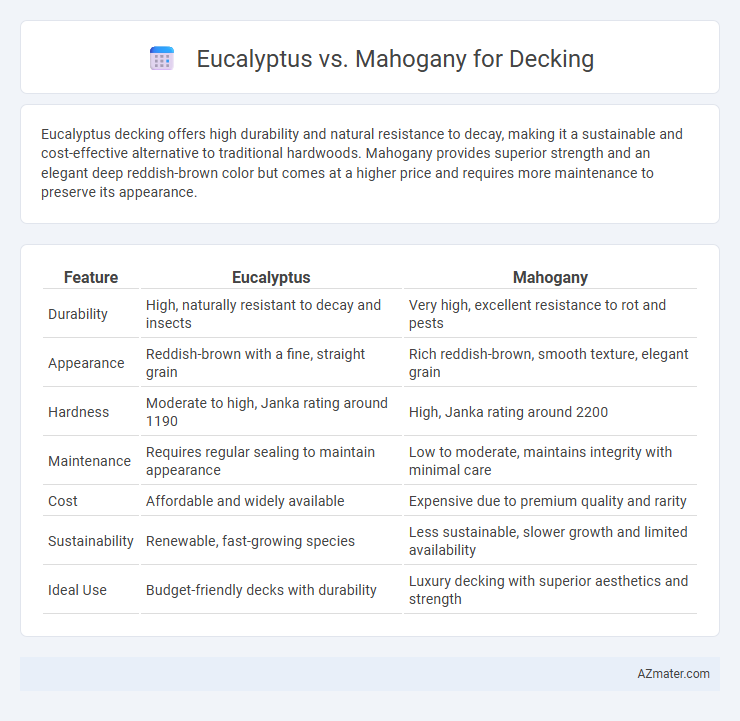Eucalyptus decking offers high durability and natural resistance to decay, making it a sustainable and cost-effective alternative to traditional hardwoods. Mahogany provides superior strength and an elegant deep reddish-brown color but comes at a higher price and requires more maintenance to preserve its appearance.
Table of Comparison
| Feature | Eucalyptus | Mahogany |
|---|---|---|
| Durability | High, naturally resistant to decay and insects | Very high, excellent resistance to rot and pests |
| Appearance | Reddish-brown with a fine, straight grain | Rich reddish-brown, smooth texture, elegant grain |
| Hardness | Moderate to high, Janka rating around 1190 | High, Janka rating around 2200 |
| Maintenance | Requires regular sealing to maintain appearance | Low to moderate, maintains integrity with minimal care |
| Cost | Affordable and widely available | Expensive due to premium quality and rarity |
| Sustainability | Renewable, fast-growing species | Less sustainable, slower growth and limited availability |
| Ideal Use | Budget-friendly decks with durability | Luxury decking with superior aesthetics and strength |
Introduction: Eucalyptus vs Mahogany for Decking
Eucalyptus and mahogany are popular hardwood choices for decking, known for their durability and aesthetic appeal. Eucalyptus offers a high density and natural resistance to rot and insects, making it a cost-effective and sustainable option, while mahogany is prized for its rich color, fine grain, and exceptional durability in outdoor conditions. Comparing these woods involves evaluating factors such as maintenance, weather resistance, and overall lifespan to determine the best fit for decking projects.
Wood Characteristics and Appearance
Eucalyptus decking features a dense, durable hardwood with a distinct reddish-brown hue that weathers to a silver-gray over time, making it resistant to decay and insect attacks. Mahogany offers a rich, deep reddish-brown color with a fine, straight grain, prized for its smooth finish and natural resistance to moisture and rot, providing an elegant and stable decking surface. Both woods require proper sealing to maintain their vibrant appearance, but eucalyptus is generally harder and more resistant to wear, while mahogany delivers superior aesthetic appeal and dimensional stability.
Durability and Longevity
Eucalyptus decking offers impressive durability due to its natural oils that resist moisture, decay, and insect attacks, providing a lifespan of up to 25 years with proper maintenance. Mahogany, renowned for its dense hardwood properties, delivers exceptional longevity, often exceeding 40 years, with superior resistance to rot and warping in outdoor environments. Both woods require sealing and regular upkeep, but mahogany's inherent strength and stability generally make it a more durable option for long-term decking projects.
Weather Resistance and Stability
Eucalyptus offers excellent weather resistance due to its natural oils that repel moisture and insects, making it highly durable for outdoor decking. Mahogany provides superior dimensional stability, resisting warping and shrinking under varying climate conditions, which ensures a long-lasting, smooth surface. Both hardwoods are prized for their resilience, but eucalyptus excels in wet environments while mahogany performs better in fluctuating temperatures.
Maintenance Requirements
Eucalyptus decking demands regular maintenance, including annual sealing or oiling to prevent cracking and warping due to its natural moisture content and exposure to elements. Mahogany, prized for its durability and natural resistance to rot and insects, requires less frequent upkeep but benefits from periodic cleaning and occasional refinishing to maintain its rich color and smooth texture. Both woods perform well outdoors but differ in maintenance intensity, with eucalyptus needing more consistent care to preserve its structural integrity and aesthetic appeal.
Sustainability and Environmental Impact
Eucalyptus decking is highly valued for its rapid growth and renewable harvesting, making it a sustainable choice that reduces deforestation pressure on tropical forests. Mahogany, while prized for its durability and rich appearance, often comes from slower-growing species that face overexploitation and habitat loss, raising sustainability concerns. Selecting FSC-certified eucalyptus wood ensures environmentally responsible sourcing and a lower carbon footprint compared to many traditional mahogany options.
Cost Comparison
Eucalyptus decking is generally more affordable than mahogany, with prices averaging between $3 to $7 per square foot, while mahogany can range from $8 to $15 per square foot due to its premium quality and durability. Maintenance costs for eucalyptus are higher because it requires regular sealing to prevent weathering, whereas mahogany's natural resistance to decay reduces long-term upkeep expenses. Choosing eucalyptus offers budget-friendly initial installation, but mahogany provides better value over time with lower maintenance and enhanced lifespan.
Ease of Installation
Eucalyptus decking offers moderate ease of installation due to its consistent grain and density, allowing standard woodworking tools to achieve clean cuts and smooth finishes. Mahogany, known for its fine texture and natural oils, is also user-friendly but may require pre-drilling to prevent splitting during fastening. Both hardwoods provide durable decking solutions, but eucalyptus often allows for quicker installation with fewer handling precautions.
Popular Applications and Trends
Eucalyptus and mahogany are popular hardwood choices for decking due to their durability and aesthetic appeal. Eucalyptus is favored for its fast growth and sustainability, making it ideal for eco-conscious projects and modern outdoor spaces, while mahogany is prized for its rich, deep tones and resistance to decay, often used in high-end or classic deck designs. Current trends show increasing use of eucalyptus in contemporary, minimalist decks, whereas mahogany remains a staple for traditional, luxurious outdoor environments.
Which is Best for Your Deck?
Eucalyptus offers exceptional durability and natural resistance to decay, making it a cost-effective choice for decking with a rich reddish-brown hue that ages gracefully. Mahogany, prized for its deep, luxurious color and superior hardness, provides excellent stability and a smooth finish, ideal for high-end decks requiring a refined appearance. The best option depends on budget, desired aesthetic, and maintenance preferences, with eucalyptus excelling in affordability and sustainability, while mahogany stands out for premium quality and long-lasting elegance.

Infographic: Eucalyptus vs Mahogany for Decking
 azmater.com
azmater.com